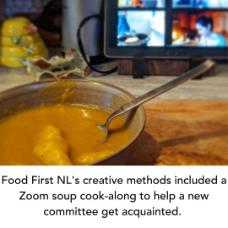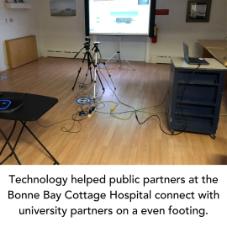Remote Possibilities: Public Engagement During a Time of Distance
By Rebecca Cohoe
As the work of public engagement has moved online, adaptation is necessary, but even with changes, sometimes it is still difficult to achieve and maintain the deep engagement and relationship that is so key to successful publicly engaged projects.
“Online doesn’t work all the time,” said Jennifer Buxton, regional engagement & experiential learning coordinator at Memorial University’s Grenfell Campus. “It is not the best, most effective tool for public engagement. People really crave that in-person connection.”
Her refreshingly blunt comment was one of the opening statements at a recent webinar organized by Memorial’s office of Public Engagement, hosted by Gavan Watson, Associate Vice-President, Teaching and Learning, and Director, CITL, about university-community public engagement in the context of the pandemic.
You can watch the entire session here, but we've distilled some of the key lesson shared, below.
Flexibility is essential
Panelist Sarah Crocker, program coordinator with Food First NL, shared how their St. John’s Food Assessment project has been impacted by the shift to more online engagement. “The tagline of our project has been to “inform, engage and take action,” but the idea of a big community meeting just wasn’t going to happen this year,” she said.
Instead, she said that flexibility has been key. Along with online engagement, they’ve found safer ways to bring people together, like a walking meeting at a community garden, rather than a sit-down session in a boardroom.
Tony Fang, a professor in Memorial’s department of Economics, and the Stephen Jarislowsky Chair in Cultural and Economic Transformation, also had to shift his approach to an ongoing research project involving newcomers and local labour markets.
“As part of our work we’re conducting personal interviews with Syrian refugees and recent immigrants, and consultations with the Association for New Canadians, St. John’s Board of Trade, and the St. John’s Farmers Market” he said. “It’s challenging in the sense that it’s more effective when you have that personal communication, but at the same time we realize we need to overcome the challenges by engaging partners.”
You can’t have engagement without accessibility
Another key challenge that each of the panelists noted was accessibility. Joanie Cranston, coordinator for the Bonne Bay Cottage Hospital Heritage Corporation, noted that in her rural community, the internet is not widely accessible, for a number of reasons, including connectivity and aging populations with less technological fluency. Her solution? She did her own version of virtual outreach, which in Bonne Bay, meant calling people on the telephone. It is not cutting edge, but it worked.
For Kathy Hawkins of InclusionNL, accessibility has always been at the core of her work increasing workplace access for people with disabilities. For her, public engagement success during COVID-19 hinged on two key areas: getting tools to support accessibility to her stakeholders, and then training them to be able to use them successfully.
“Some of the ways that we mitigated those initial challenges were through professional development with our business partners, and providing supports to implement educational tools,” she said. “It’s been a silver lining to InclusionNL, in terms of being able to have those conversations about online digital accessibility, because lots of times those conversations stay within our own environment.”
Small things matter
A number of the webinar panelists mentioned things that their organizations had done that seemed small enough, but helped to contribute to a sense of community and engagement for participants.
 Food First NL fostered a sense of community among a group of committee members, many of whom hadn’t met in person, by organizing an in-home chocolate tasting event. Participants were delivered chocolate packages (featuring Newfoundland and Labrador chocolatiers, of course!) in advance of the meeting, and sampled them together virtually. It was a quick and delicious way to help create a shared experience among people who were about to begin working together on a new project. Food First NL had also been providing childcare, homecare and travel expenses where necessary, to minimize barriers for participation.
Food First NL fostered a sense of community among a group of committee members, many of whom hadn’t met in person, by organizing an in-home chocolate tasting event. Participants were delivered chocolate packages (featuring Newfoundland and Labrador chocolatiers, of course!) in advance of the meeting, and sampled them together virtually. It was a quick and delicious way to help create a shared experience among people who were about to begin working together on a new project. Food First NL had also been providing childcare, homecare and travel expenses where necessary, to minimize barriers for participation.
Ms. Cranston explained that she had been working to use technology to bridge physical divides and place all collaborators on an even stage. She noted that sometimes video conferences can emphasize the university partner as “leader”: they are alone on a big screen in front of a room of community partners, who are less visible, and whose contributions might not be heard clearly. “It can create a barrier and an inequality,” said Ms. Cranston.
 In order to minimize that gap, Ms. Cranston set up a specialized camera system that sits in the middle of a table. It has a high-quality speaker/microphone system that lets everyone in the room both hear, and be heard. The system also includes a camera that can actually turn towards a speaker, so that whoever is sharing can be seen. “I think that using this sort of system helps give community members an equal presence and an equal voice.”
In order to minimize that gap, Ms. Cranston set up a specialized camera system that sits in the middle of a table. It has a high-quality speaker/microphone system that lets everyone in the room both hear, and be heard. The system also includes a camera that can actually turn towards a speaker, so that whoever is sharing can be seen. “I think that using this sort of system helps give community members an equal presence and an equal voice.”
Reaching out, making it work
As the pandemic continues, and conditions change, the ways that we connect across distances will also reflect that lack of certainty, but in the midst of what sometimes feels like chaos, communication and connection continue to be essential.
“We all have this sense of isolation,” said Dr. Fang. “We’re all in this together and we all need to reach out. We all need to be more innovative, flexible, and supportive to each other, and especially to the vulnerable groups.”
Ms. Crocker agreed. “With a participatory project, communication is so key, and sometimes unknowns will come up. We definitely didn’t have a global pandemic in our work plan. We’ve had to listen, adapt, and pivot.”
The entire session, including closed captioning, can be viewed here. Follow the Office of Public Engagement on Facebook to hear about upcoming events.
Rebecca Cohoe is the Manager, Engagement and Communications, with Memorial's Office of Public Engagement.